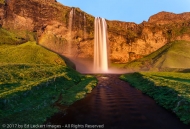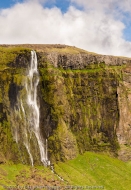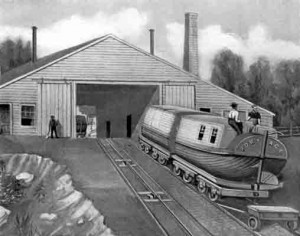


Last week I began my series on lesser-known National Parks that I had explored on my way to New England. This week we’ll look at a few more that you would never have guessed existed.
Let’s start with Indiana Dunes National Lakeshore. Now I’ve seen some beautiful sand dunes in Death Valley and in the U.S. Southwest states like Utah. But I had no idea that Indiana had sand dunes, or that any of the Great Lakes states did, for that matter. Well, it turns out they do – kind of. Let me explain.
I hopped off I-94 and drove towards the visitors’ center for the national lakeshore. I got my passport stamped (of course!) and talked to the ranger about the hiking trails there. He directed me to one of the largest dunes, and it seemed simple enough to get to, so not wanting to waste a map for my short visit there, I made a mental note of the directions and took off. Within 10 minutes I was at what I thought was the right location, right along the edge of Lake Michigan, but I didn’t see any dunes. I was starting to wish I had taken that map after all. Parking along the shore was very limited as much of this area is residential, but I finally parked at a facility just off the beach that had restrooms and ample parking. I noticed a guy coming back from the beach who looked like a local and asked him where the hiking trails to the larger dunes were. He said “There’s one of the big dunes right there!”.
I looked toward the beach and saw nothing but a tree covered hill. Hmm. So I thanked him and walked toward the beach, figuring that the dune was behind the hill. Looking back at the hill, I noticed it had a trail up to the top, and sure enough, the trail was sandy. I was looking at the dunes all the time, not realizing that they were mostly forested, or at least covered in tall grasses.
I climbed to the top of the one in front of me, which was a bit of a challenge because of the sand, but got a nice view (and a camera phone photo) of the lake for my efforts. Once at the top it was quite obvious that I was on a large dune. Who knew?
The very first place I stopped on my way east was a site along the Lewis & Clark National Historic Trail actually on Bureau of Land Management property called Pompeys Pillar National Monument. This was a bonus stop for me because it wasn’t listed in my passport, but a sign along I-94 directed visitors to a site right along the highway and it was too convenient to pass up. It seems Captain William Clark had carved his signature into a rock at this location near Billings, Montana while passing through the Yellowstone Valley area in 1806. This is the only remaining physical evidence of the expedition on the Corps of Discovery trail. Unfortunately it has to be protected behind an acrylic shield, with numerous cameras guarding the site to prevent further vandalism. I’ll never understand why people have to be jerks, but they do.
The Allegheny Portage Railroad National Historic Site in Pennsylvania was one of the more bizarre sites I visited. I’ve always loved railroads – it kind of runs in the family – but I had never seen one quite like this.
It seems the Erie Canal (I got a stamp for that, too!) was completed in 1825, linking the Atlantic Ocean with the Great Lakes and resulting in a commercial trade bonanza for New York State. Pennsylvania was on the short end of that deal, as travel by Conestoga wagons between Philadelphia and Pittsburgh took 23 days under the best of conditions, and trading moved north to the more efficient canal system. So Pennsylvania decided to build their own canal to get some of that business back. There was only once tiny little problem. Between Philadelphia and Pittsburgh stood the Allegheny Mountains.
Their first thought was to build a four mile long tunnel through the bottom of the mountains, but this was new and untested technology and it just didn’t seem feasible. So they decided to build a system of locks to raise and lower boats on their way over the top of the mountains. But locks will only get you so far, and at the steeper sections near the summit of the canal system they decided to use a train instead. That’s right, they built rails across the summit to connect the canals on either side.

Canal boats being pulled up hill on the Allegheny Portage Railroad, circa 1845. (Courtesy Pennsylvania Historical and Museum Commission)
Of course, that choice presented its own set of challenges, as the boats now had to be raised out of the canal onto rail cars, chugged across the top, and then dropped back in the water on the other side. And this was the early 1830s, when steam locomotives were smaller and not capable of hauling the loads over the steepest sections. While locomotives were used in the more level sections, stationary engines were used instead on the steepest grades. In fact, there were five inclined sections on each side, for a total of ten, each with a stationary steam engine and a continuous loop of rope, and later iron cable when the drama of broken ropes became too much. The issue of broken ropes actually inspired an ingenious auto-brake system that kicked in to prevent a free-fall of cars down the mountain. Did I mention this was the 1830s?
The Portage Railroad opened on March 18, 1834, making it possible to move people and cargo from Philadelphia to Pittsburgh in just four days. The plan worked, and east-west trade returned to Pennsylvania. The system was only in place for twenty years before the Pennsylvania Railroad replaced the canal system, but it was the Allegheny Portage Railroad that began an era of prosperity that helped lead Pennsylvania’s industrial growth. You can watch a short eight minute WQED TV production about the Allegheny Portage Railroad here.
I hope you enjoyed these quick visits to a few National Park sites. I’ll tell you about more of them in future weeks, but for now I need to start packing for my next adventure – and this one’s going to be really cool!
See you soon!
